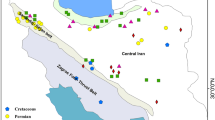Abstract
An analytical method for determining 239Pu and 240Pu in marine sediment samples, which uses quadrupole ICP-MS, was developed in this work. A simple anion-exchange chromatography system was employed for the separation and purification of Pu from the sample matrix. A sufficient decontamination factor of 1.4×104 for U, which interferes with the determination of 239Pu, was achieved. High sensitivity Pu determination was obtained, which led to an extremely low concentration detection limit of ~8 fg/ml (0.019 mBq/ml for 239Pu; 0.071 mBq/ml for 240Pu) in a sample solution, or an absolute detection limit of 42 fg in a 5 ml sample solution, by using the shield torch technique. Analytical results for the determination of the 239+240Pu and the 240Pu/239Pu ratio in IAEA 368 (ocean sediment) reference material indicated that the accuracy of the method was satisfactory. The method developed was successfully applied to a study of Pu behavior in the sediments from Sagami Bay, Japan. The observed high 240Pu/239Pu ratio in the sediment core indicated that there was additional Pu input derived from close-in fallout in addition to the global fallout.




Similar content being viewed by others
References
Dozol M, Hagemann R (1993) Pure Appl Chem 65:1081–1102
Pockley P (2000) Nature 404:797–797
Cochran JK (1985) Geochim Cosmochim Acta 49:1195–1210
Livingston HD, Anderson RF (1983) Nature 303:228–231
Buesseler KO (1997) J Environ Radioactiv 36:69–83
Yamada M, Nagaya Y (2000) J Radioanal Nucl Chem 245:273–279
Yamada M, Aono T (2002) Sci Total Environ 287:97–105
Buesseler KO, Sholkovitz ED (1987) Geochim Cosmochim Acta 51:2623–2637
Skwarzec B, Struminska DI, Prucnal M (2003) J Environ Radioactiv 70:237–252
Buesseler KO, Halverson JE (1987) J Environ Radioactiv 5:425–444
Cooper LW, Kelley JM, Bond LA, Orlandini KA, Grebmeier JM (2000) Mar Chem 69:253–276
Kershaw PJ, Sampson KE, McCarthy W, Scott RD (1995) J Radioanal Nucl Chem 198:113–124
Muramatsu Y, Uchida S, Tagami K, Yoshida S, Fujikawa T (1999) J Anal Atom Spectrom 14:859–865
Kim CS, Kim CK, Lee JI, Lee KJ (2000) J Anal Atom Spectrom 15:247–255
Keterer ME, Watson BR, Matisoff G, Wilson CG (2002) Environ Sci Technol 36:1307–1311
Eroglu AE, McLeod CW, Leonard KS, McCubbin D (1998) Spectrochim Acta B 53:1221–1233
Muramatsu Y, Yoshida S, Tanaka A (2003) J Radioanal Nucl Chem 255:477–480
Muramatsu Y, Ruhm W, Yoshida S, Tagami K, Uchida S, Wirth E (2000) Environ Sci Technol 34:2913–2917
Boulyga SF, Zoriy M, Ketterer ME, Becker JS (2003) J Environ Monit 5:661–666
Anderson RF, Fleer AP (1982) Anal Chem 54:1142–1147
Chiappini R, Taillade JM, Brebion S (1996) J Anal Atom Spectrom 11:497–504
Cizdziel J, Hodge V, Faller S (1999) Health Phys 77:67–75
Mietelski JW, Was B (1995) Appl Radiat Isot 46:1203–1211
UNSCEAR (United Nations Scientific Committee on the Effects of Atomic Radiation Exposures to the Public from Man-made Sources of Radiation) (2000) In: Sources and effects of ionizing radiation. United Nations, New York
Yamada M, Nagaya Y (2000) J Radioanal Nucl Chem 246:369–378
Zheng J, Yamada M (2003) Environ Sci Technol (in press)
Muramatsu Y, Hamilton T, Uchida S, Tagami K, Yoshida S, Robison W (2001) Sci Total Environ 278:151–159
Author information
Authors and Affiliations
Corresponding author
Rights and permissions
About this article
Cite this article
Zheng, J., Yamada, M., Wang, Z. et al. Determination of plutonium and its isotopic ratio in marine sediment samples using quadrupole ICP-MS with the shield torch system under normal plasma conditions. Anal Bioanal Chem 379, 532–539 (2004). https://doi.org/10.1007/s00216-004-2626-x
Received:
Revised:
Accepted:
Published:
Issue Date:
DOI: https://doi.org/10.1007/s00216-004-2626-x




